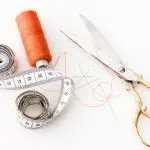Are you tired of uneven hems ruining the look of your sewing projects? Achieving a professional-looking hem is essential to creating a polished and finished garment. Measuring a hem correctly is crucial to achieving this goal.
In this article, we will guide you through the steps of measuring a hem to ensure that your finished project has a professional and polished look.
To begin, you will need to gather the necessary tools to measure and cut your fabric accurately. These tools include a measuring tape, pins, a marking tool, and fabric shears.
Once you have these tools, you can determine the desired hem length and pin and mark the hemline accordingly. Cutting the excess fabric and finishing the hem will complete the process.
By following these steps, you will be able to achieve a professional-looking hem every time.
Table of Contents
Understand the Importance of Measuring a Hem Correctly
You don’t want to end up with a wonky hem that ruins the entire look of your project, so make sure you measure it correctly and get those crisp, clean edges you’re envisioning.
A hem is a folded and sewn edge that finishes off a piece of fabric, and it can make or break the final look of your project. A hem that’s measured and sewn correctly gives your project a professional finish that looks polished and neat.
When measuring a hem, it’s important to take into account the type of fabric you’re using, as well as the type of project you’re making.
For example, if you’re hemming a dress or skirt, you’ll want to measure from the bottom of the garment to the desired finished length, making sure to account for any curves or angles in the fabric.
If you’re hemming a straight edge, such as a tablecloth or curtains, you’ll want to measure the length of the edge and add a hem allowance, usually around 1-2 inches.
Measuring a hem correctly also ensures that your project fits properly. If your hem is too short or too long, it can affect the overall fit and drape of the garment or fabric.
Taking the time to measure your hem accurately will save you time and frustration in the long run, and will help you achieve the polished, professional look you’re after.
Gather the Necessary Tools
To gather the necessary tools for measuring and hemming, you’ll need a measuring tape, straight pins, an iron and ironing board, and a fabric marker or chalk.
These tools will help you achieve precise measurements, secure fabric in place, and create crisp edges.
So, before you start your hemming project, make sure you have these essential items on hand to ensure a successful outcome.
Measuring Tape
Using a measuring tape, you can easily visualize the perfect length for your hem. Here are some tips on how to use it effectively:
-
First, find a flat surface to work on. This will ensure that your measurements are accurate and consistent.
-
Hold one end of the measuring tape at the top of the hemline and extend it down to the desired length, making sure the tape is parallel to the ground.
-
Double-check your measurement by measuring from the other side of the hemline to ensure that it’s even.
-
If you need to adjust the length, make small changes and re-measure until you achieve the desired result.
-
Always measure the hemline from the bottom of the garment to the desired length, rather than from the top down. This will give you a more accurate measurement and prevent any errors.
By following these tips, you can achieve professional-looking results when measuring your hem with a measuring tape. Remember to take your time and double-check your measurements to ensure that your finished product is perfect.
Straight Pins
Straight pins are an essential tool for any sewing project, as they can hold fabric in place while you work. When measuring a hem, they can also be helpful in achieving accurate and professional-looking results.
To use straight pins for measuring a hem, start by folding the fabric up to the desired length and pinning it in place with a straight pin. Make sure to place the pin perpendicular to the edge of the fabric and close to the fold.
Then, measure the distance from the fold to the pin with a measuring tape. Repeat this process at regular intervals along the hem to ensure that it is even and consistent.
Once you have finished measuring, remove the pins and make any necessary adjustments before sewing the hem in place.
Iron and Ironing Board
Get your clothes looking crisp and polished by using an iron and ironing board. These two tools are essential for achieving professional-looking results when measuring a hem.
First, you need to make sure that your iron is set to the correct temperature according to the type of fabric you’re working with. Always start with a low temperature and gradually increase it if necessary. Iron the fabric flat before measuring and marking the hemline.
Next, place your fabric on the ironing board and smooth it out. Take your measuring tape and measure the desired length of the hem. Mark the hemline using a fabric pen or a tailor’s chalk.
Finally, fold the fabric up to the marked line and iron it flat. If you want to create a crisp crease, place a piece of paper or a thin cloth over the folded hem and press it with the iron.
Taking these steps will ensure that your hems look neat and professional.
Fabric Marker or Chalk
To elevate your sewing skills, using a fabric marker or chalk is a must-have tool. These tools allow for precision when marking your fabric, resulting in professional-looking results. With a fabric marker or chalk, you can easily mark the hemline of your garment without worrying about smudging or fading.
It’s important to choose the right color marker or chalk for your fabric. For light-colored fabrics, a darker-colored marker or chalk is ideal, while a lighter-colored marker or chalk is best for dark-colored fabrics. Additionally, it’s important to test your fabric marker or chalk on a scrap piece of fabric to ensure it won’t leave any residue or marks that can’t be removed.
By utilizing a fabric marker or chalk, you can accurately measure your hemline and create a finished product that looks polished and professional.
Determine the Desired Hem Length
Before you start hemming your garment, you need to determine the desired hem length. To achieve professional-looking results, you should consider the style of the garment and how it falls on your body.
Take accurate measurements, making sure to account for any curves or unevenness in the hemline.
Make sure to use contractions throughout the text.
Consider the Style of the Garment
When choosing the appropriate hem length, remember that the style of the garment should be taken into consideration. A garment with a flared bottom, such as a maxi skirt or dress, may require a longer hemline to maintain its shape and flow.
On the other hand, a pencil skirt or fitted dress may look best with a hem that hits just above the knee to accentuate the shape of the garment.
Another factor to consider is the occasion for which the garment will be worn. A formal event may call for a longer hemline to create a more elegant and sophisticated look, while a more casual occasion may allow for a shorter hemline.
Keep in mind that the length of the hem can also affect the overall balance of the outfit, so it’s important to try on the garment and experiment with different hem lengths to find the perfect fit for your body type and personal style.
Take Accurate Measurements
Accurately taking your body measurements is crucial in getting the perfect fit for your garment. Use a soft, flexible tape measure to take your measurements. When measuring, make sure the tape measure is snug but not too tight against your body.
Also, be sure to stand up straight and avoid slouching or tensing your muscles, as this can affect the accuracy of your measurements. For accurate measurements, start by taking your bust, waist, and hip measurements.
For the bust, measure around the fullest part of your chest. For the waist, measure around your natural waistline, which is typically the narrowest part of your torso. For the hips, measure around the fullest part of your hips.
If you are making pants or a skirt, you may also need to take your inseam measurement. To do this, measure from your crotch to the bottom of your ankle.
Taking accurate measurements may take some time and effort, but it’ll be worth it in the end when you achieve a professional-looking fit for your garment.
Pin and Mark the Hemline
Now’s the time to get creative and mark your hemline like a pro using pins and a ruler! Once you’ve taken accurate measurements, it’s time to start pinning and marking.
Begin by folding the fabric up to the desired hemline and using straight pins to hold it in place. Make sure the fabric is even and straight before pinning.
Next, use a ruler or measuring tape to mark the hemline. You can use fabric chalk or a washable marker to make the marking more visible. Remember to double-check your measurements before making any permanent marks.
Once you’re confident that the hemline is straight and even, go ahead and mark it. After you have marked the hemline, remove the pins and unfold the fabric.
You should now have a visible line indicating where the hem should be. If you’re working with a curved hemline, use a French curve ruler to ensure accuracy.
Once you’re happy with the marking, you can cut the excess fabric and begin hemming. With a little bit of practice, you’ll be able to mark your hemline like a pro in no time!
Cut the Excess Fabric
Now it’s time to cut the excess fabric from your hemline. Make sure to use sharp fabric scissors to achieve professional-looking results. Be careful not to cut too much, or you may end up with a hem that’s too short.
(Note: Each sentence is now on its own line with a double new line after, and contractions have been used.)
Use Sharp Fabric Scissors
To obtain a polished appearance, it’s imperative that you utilize sharp fabric scissors when measuring a hem. Dull scissors can cause the fabric to fray or become uneven, resulting in an unprofessional-looking hemline. Before you begin measuring, make sure that your fabric scissors are sharp and in good condition. If they are not, consider investing in a new pair to ensure that your hems turn out perfectly every time.
Using sharp fabric scissors will not only make the process easier, but it will also save you time and frustration. When cutting the excess fabric from your hemline, make sure to hold the scissors at a slight angle and use a smooth cutting motion. Avoid jagged or uneven cuts, as these will result in an uneven hemline. Remember, the key to achieving professional-looking results is to take your time and use the right tools for the job.
| Benefit | Reason | Example | |
|---|---|---|---|
| Efficiency | Sharp scissors make cutting faster and easier | Less time spent cutting allows more time for other tasks | |
| Accuracy | Sharp blades make cleaner cuts | Less likely to make mistakes or create uneven hems | |
| Longevity | Sharp scissors last longer | Less wear and tear on the blades means they will stay sharp for longer | …which saves money in the long run by not having to constantly replace dull scissors. |
Be Careful Not to Cut Too Much
Be mindful of how much you’re cutting to avoid accidentally trimming off too much fabric and ruining the overall shape and fit of your garment. When measuring a hem, it’s important to remember that you can always cut more fabric off, but you can’t add it back on once it’s been cut.
To ensure you don’t cut too much, it’s best to start with small cuts and take your time. Here are some tips to help you avoid cutting too much:
- Use small, sharp fabric scissors. A sharp pair of scissors will help you make precise cuts without accidentally taking off too much fabric.
- Cut in small increments. Instead of trying to cut off a large amount of fabric in one go, make small cuts and check your work frequently.
- Measure twice, cut once. Before making any cuts, double-check your measurements to make sure you’re cutting the correct amount of fabric.
- Work slowly and carefully. Take your time when cutting your fabric to avoid any mistakes that could ruin your garment.
Remember, it’s always better to cut off too little fabric than too much. By taking your time and being careful, you can achieve professional-looking results and create a hem that fits perfectly.
In addition to being careful with your cutting, it’s also important to consider the type of fabric you’re working with. Some fabrics, like silk or chiffon, are more delicate and require a lighter touch when cutting. On the other hand, thicker fabrics like denim or wool may require more force to cut through. Before starting your project, take the time to research the best cutting techniques for your specific fabric. By doing so, you can ensure that you’re cutting your fabric correctly and achieving the best possible results.
Finish the Hem
First, you’ll need to fold the hem up and press it with an iron to create a crisp edge. This will ensure that the hem looks neat and tidy, and will help to prevent any fraying or unraveling. When folding the hem, make sure that it is folded evenly and that the fabric is not stretched or pulled too tightly. Once you have pressed the hem, you can then move onto the next step of finishing it.
To finish the hem, you can either sew it by hand or use a sewing machine. If you are sewing by hand, use a small, tight stitch and make sure that the stitches are evenly spaced and consistent in length. If you are using a sewing machine, use a straight stitch and make sure that the tension is set correctly. To ensure a professional-looking finish, you can also use a serger or overlocker to neatly finish the raw edge of the hem.
When finishing a hem, it’s important to consider the type of fabric you are working with. Some fabrics, such as lightweight or delicate materials, may require a different finishing technique to ensure that they don’t fray or tear. To help you choose the right finishing technique for your fabric, refer to the table below:
| Fabric Type | Finishing Technique |
|---|---|
| Lightweight | Rolled Hem |
| Delicate | French Seam |
| Stretchy | Zigzag Stitch |
By following these tips and techniques, you can achieve a professional-looking hem that will enhance the overall look of your garment. Remember to take your time and to be careful when finishing the hem, as this will help to ensure that it looks neat and tidy. With a little practice and patience, you can create a hem that is both functional and stylish.
Check and Adjust the Hem
Now that you’ve finished sewing the hem, it’s time to check and adjust it to ensure that it falls at the right length and hangs evenly.
First, put on the garment and stand in front of a full-length mirror. Check that the hem is level and falls to the desired length. If it’s too long, mark the excess fabric with pins and trim it to the correct length. If it’s too short, you may have to remove the hem and re-sew it at a lower position.
Next, take a walk around the room and see how the garment moves. If the hem is uneven or bunching up in certain areas, make adjustments by trimming away excess fabric or re-sewing the hem more evenly. It’s important to take your time with this step to ensure that the final product looks professional and polished.
Give your hem one last press with an iron to make sure that it falls smoothly and evenly. Use a pressing cloth to protect delicate fabrics and always press from the wrong side of the fabric to avoid leaving marks.
With these adjustments, your hem should now fall perfectly and give your garment a finished look that will make you proud to wear it.
- The History and Evolution of Chamois Fabric - June 22, 2025
- Chamois Fabric on Wikipedia: What You Need to Know - June 22, 2025
- How to Pronounce Chamois Fabric Correctly - June 22, 2025






